
HPE’s Spaceborne Computer-2 (SBC-2) system – soon to be deployed on the international space station (ISS) – will enable many new activities on the space station that require advanced data processing. It will also connect via satellite to Microsoft’s cloud data centres on Earth for more demanding requirements.
However, despite the potential offered by SBC-2, the new computer system will be vulnerable to the same environmental challenges of its predecessor.
Local processing and twice the power
SBC-2, which is based on HPE’s Edgeline Converged Edge system, represents edge computing, an activity that enables data processing to be carried out in remote locations, often far from traditional or cloud data centres. Traditionally, data collected in space, including data to support the study of weather patterns, climate science, national security and disaster response, had to be sent to Earth to be processed, either via satellite communications or using transported hard drives. This process was either costly in terms of the amount of bandwidth it needed, or resulted in time delays which limited research efficiency.
Processing locally collected data in space can speed-up and lower the cost of space exploration, while reducing the time in which data can be analysed and utilized. For example, ISS-based astronauts and researchers will be able to use locally processed data to support a range of activities that include DNA sequencing, doing ultrasound medical imaging for astronaut health care, modelling dust storms to assist with Mars mission planning, and analysing satellite data.
SBC-2 offers twice the amount of data processing power than its predecessor, SBC-1, which was sent to the ISS in August 2017 and which returned to Earth in May 2019. SBC-2 is also equipped with GPU capabilities to support projects that leverage artificial intelligence and machine learning techniques. Additionally, the new computer system will connect to Microsoft’s Azure Cloud via NASA and HPE ground stations on Earth. This is designed to ensure that more complex data, which requires in-depth analysis and longer-term storage, can be transmitted to one of Microsoft’s terrestrial cloud data centres.
SBC-2 uses protective software – for now
However, despite these new capabilities and stronger the potential of SBC-2, the new computer system will encounter the same environmental challenges faced by SBC-1. Outside Earth’s protective atmosphere, IT equipment is exposed to high levels of cosmic radiation from deep space, as well as particles from the Sun.
How well do you really know your competitors?
Access the most comprehensive Company Profiles on the market, powered by GlobalData. Save hours of research. Gain competitive edge.

Thank you!
Your download email will arrive shortly
Not ready to buy yet? Download a free sample
We are confident about the unique quality of our Company Profiles. However, we want you to make the most beneficial decision for your business, so we offer a free sample that you can download by submitting the below form
By GlobalDataFurthermore, machinery on the ISS can experience power and temperature fluctuations, which can damage electronics. Compounding these risks is the fact that SBC-1 never benefitted from a proper failure analysis autopsy, owing to disruptions caused by the Covid-19 pandemic. Had it done so, lessons might have been learned which could have influenced the design of SBC-2.
Instead of adding extra protective hardware, which may have been prohibitively expensive, HPE opted to protect SBC-2 using software.
This software will monitor various parameters, including power, temperature and voltage and, in the event of something going wrong, will implement responsive measures that include full shutdown. In the short term such measures will help to guard against the risk of catastrophic failure. Longer term however, it is likely that more robust protective measures will be needed, if the benefits of edge computing in outer space are to be fully realised.





Related Company Profiles
ISS AS
Microsoft Corp